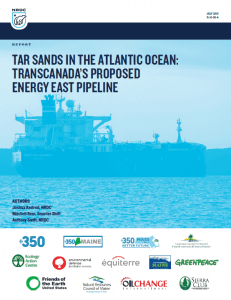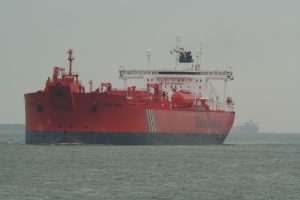The opposition to the Energy East pipeline and tanker proposal continues to grow, not just in Canada, but in the U.S. as well. This week, the U.S.-based Natural Resources Defense Council (NRDC), in partnership with Environmental Defence and other organizations, launched a new report highlighting how Energy East would threaten the Canadian and U.S. East Coast. The risks to fragile marine ecosystems and local communities are one more reason to speak out against Energy East.
 The report, Tar Sands in the Atlantic Ocean: TransCanada’s Proposed Energy East Pipeline, shows that Energy East would increase current crude oil tanker traffic in the Bay of Fundy and down the Atlantic coast by 300 to 500 per cent.
The report, Tar Sands in the Atlantic Ocean: TransCanada’s Proposed Energy East Pipeline, shows that Energy East would increase current crude oil tanker traffic in the Bay of Fundy and down the Atlantic coast by 300 to 500 per cent.
Energy East would result in an additional 300 supertankers departing from Saint John, New Brunswick every year, posing a massive threat to endangered species like the North Atlantic Right Whale and the Fin Whale. Any oil spill could permanently harm fish, lobster and scallop populations in the Bay of Fundy and along the East Coast, threatening local livelihoods and the economy.
The report also confirms that Energy East would be an export pipeline. After offloading small quantities of oil in Quebec and New Brunswick, TransCanada would ship up to 900,000 barrels of oil per day to U.S. East Coast and Gulf Coast refineries that can handle heavy crude like diluted bitumen. Energy East isn’t about replacing imports. Even the Irving Oil refinery, the pipeline’s slated terminal, has admitted that it would still import Saudi oil even if Energy East is built.
 As the massive risks of Energy East are coming to light, it’s no surprise that U.S. groups like the NRDC are joining the opposition. Any Energy East tanker spill in the Atlantic could have devastating impacts on the U.S. East Coast. Let’s not forget that tar sands spills are extremely difficult to clean up. The U.S. National Academy of Sciences has determined that diluted bitumen behaves differently from common crude oil, making any clean-up technically challenging and highly expensive.
As the massive risks of Energy East are coming to light, it’s no surprise that U.S. groups like the NRDC are joining the opposition. Any Energy East tanker spill in the Atlantic could have devastating impacts on the U.S. East Coast. Let’s not forget that tar sands spills are extremely difficult to clean up. The U.S. National Academy of Sciences has determined that diluted bitumen behaves differently from common crude oil, making any clean-up technically challenging and highly expensive.
One of the report’s key recommendations is a moratorium on tar sands oil tanker traffic in North American waters. Until we have better research on the behaviour of tar sands oil in marine ecosystems and spill response plans in place for the U.S. and Canadian Coast Guards, tar sands tankers should not navigate North American waters.
Prime Minister Justin Trudeau has already said that British Columbia’s Great Bear Rainforest is no place for an oil pipeline and the federal government has promised a tanker ban on the North Coast of B.C. If transporting tar sands oil is too dangerous for northern B.C., then what makes it safe for the boreal forest of eastern Canada, the iconic Bay of Fundy, or North America’s Atlantic coast?
 Public opposition to fossil fuels and pipelines is growing across Canada and the U.S. for good reason. Transporting fossil fuels by pipeline, rail or tanker is risky. And at a time when Canada is getting serious about climate change, we need to be moving away from building new fossil fuel infrastructure and instead focus our efforts on building a low-carbon, clean economy. Speak out today and tell our elected federal officials to reject the risky Energy East pipeline.
Public opposition to fossil fuels and pipelines is growing across Canada and the U.S. for good reason. Transporting fossil fuels by pipeline, rail or tanker is risky. And at a time when Canada is getting serious about climate change, we need to be moving away from building new fossil fuel infrastructure and instead focus our efforts on building a low-carbon, clean economy. Speak out today and tell our elected federal officials to reject the risky Energy East pipeline.








